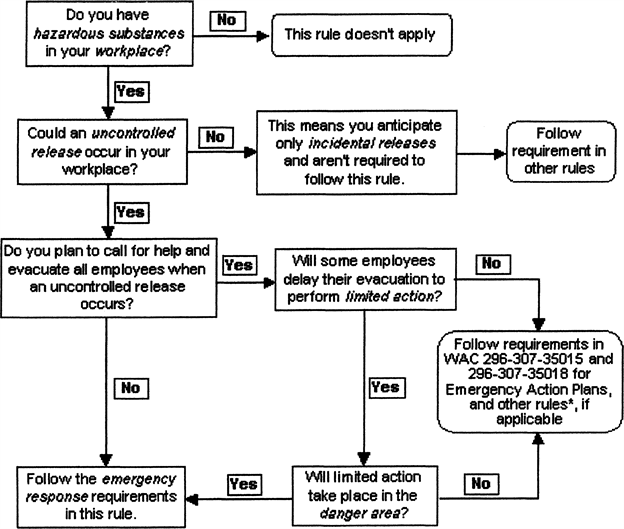Emergency response to hazardous substance releases.
To state the minimum requirements that help the employer protect the safety and health of its employees during a response to hazardous substance releases in the employer's workplace or any other location.
Requirements of this rule that apply to the employer's workplace.
This section applies if the employer's employees are, or could become, involved in responding to uncontrolled releases of hazardous substances in the workplace or any other location. Use the scope flow chart, and definitions that follow, to determine if this section applies to the employer's workplace(s). Defined words are italicized in the flow chart.
307 - FLOWCHART
 |
*The flow chart references other rules applicable to the workplace depending on conditions and hazards.
Examples include:
(1) Chapter 296-828 WAC, Hazardous chemicals in laboratories.
(2) WAC 296-307-594, Respiratory protection.
Definitions that apply to the flow chart (see WAC 296-307-70480 for additional definitions used in this section):
Danger area. Areas where conditions pose a serious danger to employees, such as areas where:
(a) Immediately dangerous to life or health (IDLH) conditions could exist;
or
(b) High levels of exposure to toxic substances could exist;
or
(c) There is a potential for exceeding the lower explosive limit (LEL), also known as the lower flammability limit (LFL), of a substance.
Emergency response. A response to an anticipated release of a hazardous substance that is, or could become, an uncontrolled release.
Hazardous substance. Any biological, radiological, or chemical substance that can have adverse effects on humans. (See WAC 296-307-70480 for a more specific definition.)
Immediately dangerous to life or health (IDLH). Any atmospheric condition that would:
(a) Cause an immediate threat to life;
(b) Cause permanent or delayed adverse health effects;
(c) Interfere with an employee's ability to escape.
Incidental release. A release that can be safely controlled at the time of the release and does not have the potential to become an uncontrolled release.
Example of a situation that results in an incidental release:
A tanker truck is receiving a load of hazardous liquid when a leak occurs. The driver knows the only hazard from the liquid is minor skin irritation. The employer has trained the driver on procedures and provided equipment to use for a release of this quantity. The driver puts on skin protection and stops the leak. A spill kit is used to contain, absorb, and pick up the spilled material for disposal.
Limited action. Action necessary to:
(a) Secure an operation during emergency responses;
or
(b) Prevent an incident from increasing in severity.
Examples include shutting down processes and closing emergency valves.
Release. A spill, leak, or other type of hazardous substance discharge.
Uncontrolled release. A release where significant safety and health risks could be created. Releases of hazardous substances that are either incidental or could not create a safety or health hazard (i.e., fire, explosion or chemical exposure) are not considered to be uncontrolled releases.
(a) Examples of conditions that could create a significant safety and health risk:
(i) Large-quantity releases;
(ii) Small-releases that could be highly toxic;
(iii) Airborne exposures that could exceed a WISHA permissible exposure limit or a published exposure limit and employees are not adequately trained or equipped to control the release.
(b) Example of an uncontrolled release:
A forklift driver knocks over a container of a solvent-based liquid, releasing the contents onto the warehouse floor. The driver has been trained to recognize the vapor is flammable and moderately toxic when inhaled. The driver has not been trained or provided appropriate equipment to address this type of spill. In this situation, it is not safe for the driver to attempt a response. The driver needs to notify someone of the release so an emergency response can be initiated.
Workplace.
(a) A fixed facility;
or
(b) A temporary location (such as a traffic corridor);
or
(c) Locations where employees respond to emergencies.
Summary:
Employer responsibility:
To anticipate, plan for, and manage emergency response operations so employees are protected from hazardous substances and conditions.
Note: | Other chapters may apply to the employer's workplace, such as: Chapter 296-62 WAC, General occupational health standards. |
The employer will find some safety and health requirements (for example, personal protective equipment) are addressed on a general level in the core rules, while being addressed for a specific application in this section. When this happens, both requirements apply and should not conflict.
If the employer is uncertain which requirements to follow, the employer must comply with the more protective requirement. Contact the local L&I office if assistance is needed in making this determination.
The employer must meet the requirements… | in this section: |
Planning. | WAC 296-307-70410 |
Training. | WAC 296-307-70415 |
Medical surveillance. | WAC 296-307-70420 |
Keep records. | WAC 296-307-70425 |
Incident requirements. | WAC 296-307-70430 |
Implement and maintain an incident command system (ICS) (incident command system). | WAC 296-307-70435 |
Prepare skilled support personnel. | WAC 296-307-70440 |
Make sure the incident commander oversees activities during the response. | WAC 296-307-70445 |
Use the buddy system in danger areas. | WAC 296-307-70450 |
Provide rescue and medical assistance. | WAC 296-307-70455 |
Personal protective equipment. | WAC 296-307-70460 |
Control hazards created by personal protective equipment (PPE). | WAC 296-307-70465 |
Use personal protective equipment (PPE) properly. | WAC 296-307-70470 |
Postemergency response. | WAC 296-307-70475 |
Definitions. | WAC 296-307-70480 |